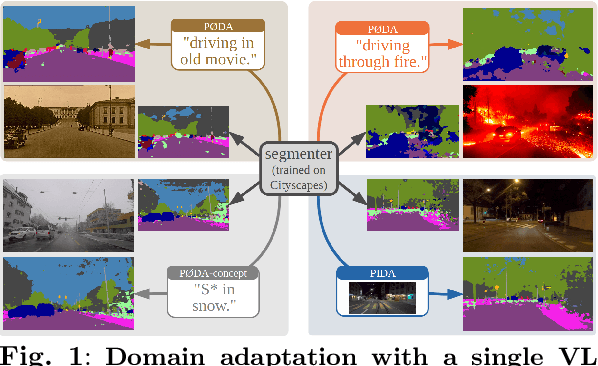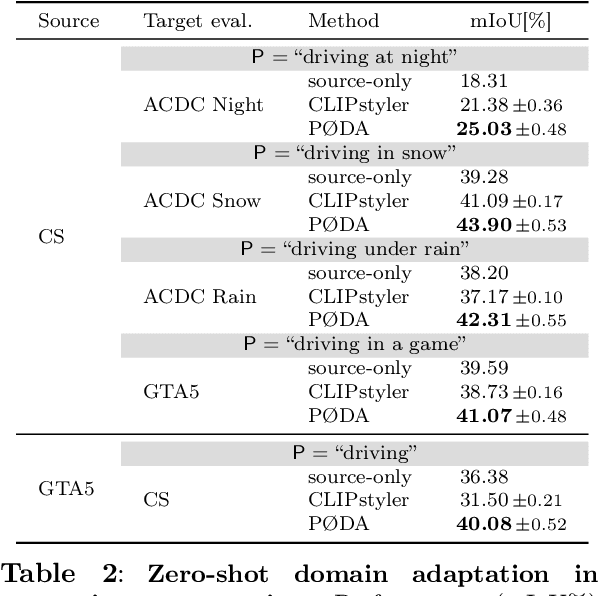Patrick Pérez
DANTE
Vision-Speech Models: Teaching Speech Models to Converse about Images
Mar 19, 2025Abstract:The recent successes of Vision-Language models raise the question of how to equivalently imbue a pretrained speech model with vision understanding, an important milestone towards building a multimodal speech model able to freely converse about images. Building such a conversational Vision-Speech model brings its unique challenges: (i) paired image-speech datasets are much scarcer than their image-text counterparts, (ii) ensuring real-time latency at inference is crucial thus bringing compute and memory constraints, and (iii) the model should preserve prosodic features (e.g., speaker tone) which cannot be inferred from text alone. In this work, we introduce MoshiVis, augmenting a recent dialogue speech LLM, Moshi, with visual inputs through lightweight adaptation modules. An additional dynamic gating mechanism enables the model to more easily switch between the visual inputs and unrelated conversation topics. To reduce training costs, we design a simple one-stage, parameter-efficient fine-tuning pipeline in which we leverage a mixture of image-text (i.e., "speechless") and image-speech samples. We evaluate the model on downstream visual understanding tasks with both audio and text prompts, and report qualitative samples of interactions with MoshiVis. Our inference code will be made available, as well as the image-speech data used for audio evaluation.
High-Fidelity Simultaneous Speech-To-Speech Translation
Feb 05, 2025Abstract:We introduce Hibiki, a decoder-only model for simultaneous speech translation. Hibiki leverages a multistream language model to synchronously process source and target speech, and jointly produces text and audio tokens to perform speech-to-text and speech-to-speech translation. We furthermore address the fundamental challenge of simultaneous interpretation, which unlike its consecutive counterpart, where one waits for the end of the source utterance to start translating, adapts its flow to accumulate just enough context to produce a correct translation in real-time, chunk by chunk. To do so, we introduce a weakly-supervised method that leverages the perplexity of an off-the-shelf text translation system to identify optimal delays on a per-word basis and create aligned synthetic data. After supervised training, Hibiki performs adaptive, simultaneous speech translation with vanilla temperature sampling. On a French-English simultaneous speech translation task, Hibiki demonstrates state-of-the-art performance in translation quality, speaker fidelity and naturalness. Moreover, the simplicity of its inference process makes it compatible with batched translation and even real-time on-device deployment. We provide examples as well as models and inference code.
Domain Adaptation with a Single Vision-Language Embedding
Oct 28, 2024



Abstract:Domain adaptation has been extensively investigated in computer vision but still requires access to target data at the training time, which might be difficult to obtain in some uncommon conditions. In this paper, we present a new framework for domain adaptation relying on a single Vision-Language (VL) latent embedding instead of full target data. First, leveraging a contrastive language-image pre-training model (CLIP), we propose prompt/photo-driven instance normalization (PIN). PIN is a feature augmentation method that mines multiple visual styles using a single target VL latent embedding, by optimizing affine transformations of low-level source features. The VL embedding can come from a language prompt describing the target domain, a partially optimized language prompt, or a single unlabeled target image. Second, we show that these mined styles (i.e., augmentations) can be used for zero-shot (i.e., target-free) and one-shot unsupervised domain adaptation. Experiments on semantic segmentation demonstrate the effectiveness of the proposed method, which outperforms relevant baselines in the zero-shot and one-shot settings.
Fine-Tuning CLIP's Last Visual Projector: A Few-Shot Cornucopia
Oct 07, 2024



Abstract:We consider the problem of adapting a contrastively pretrained vision-language model like CLIP (Radford et al., 2021) for few-shot classification. The existing literature addresses this problem by learning a linear classifier of the frozen visual features, optimizing word embeddings, or learning external feature adapters. This paper introduces an alternative way for CLIP adaptation without adding 'external' parameters to optimize. We find that simply fine-tuning the last projection matrix of the vision encoder leads to strong performance compared to the existing baselines. Furthermore, we show that regularizing training with the distance between the fine-tuned and pretrained matrices adds reliability for adapting CLIP through this layer. Perhaps surprisingly, this approach, coined ProLIP, yields performances on par or better than state of the art on 11 few-shot classification benchmarks, few-shot domain generalization, cross-dataset transfer and test-time adaptation. Code will be made available at https://github.com/astra-vision/ProLIP .
Winner-takes-all learners are geometry-aware conditional density estimators
Jun 07, 2024



Abstract:Winner-takes-all training is a simple learning paradigm, which handles ambiguous tasks by predicting a set of plausible hypotheses. Recently, a connection was established between Winner-takes-all training and centroidal Voronoi tessellations, showing that, once trained, hypotheses should quantize optimally the shape of the conditional distribution to predict. However, the best use of these hypotheses for uncertainty quantification is still an open question.In this work, we show how to leverage the appealing geometric properties of the Winner-takes-all learners for conditional density estimation, without modifying its original training scheme. We theoretically establish the advantages of our novel estimator both in terms of quantization and density estimation, and we demonstrate its competitiveness on synthetic and real-world datasets, including audio data.
OccFeat: Self-supervised Occupancy Feature Prediction for Pretraining BEV Segmentation Networks
Apr 22, 2024



Abstract:We introduce a self-supervised pretraining method, called OcFeat, for camera-only Bird's-Eye-View (BEV) segmentation networks. With OccFeat, we pretrain a BEV network via occupancy prediction and feature distillation tasks. Occupancy prediction provides a 3D geometric understanding of the scene to the model. However, the geometry learned is class-agnostic. Hence, we add semantic information to the model in the 3D space through distillation from a self-supervised pretrained image foundation model. Models pretrained with our method exhibit improved BEV semantic segmentation performance, particularly in low-data scenarios. Moreover, empirical results affirm the efficacy of integrating feature distillation with 3D occupancy prediction in our pretraining approach.
POP-3D: Open-Vocabulary 3D Occupancy Prediction from Images
Jan 17, 2024



Abstract:We describe an approach to predict open-vocabulary 3D semantic voxel occupancy map from input 2D images with the objective of enabling 3D grounding, segmentation and retrieval of free-form language queries. This is a challenging problem because of the 2D-3D ambiguity and the open-vocabulary nature of the target tasks, where obtaining annotated training data in 3D is difficult. The contributions of this work are three-fold. First, we design a new model architecture for open-vocabulary 3D semantic occupancy prediction. The architecture consists of a 2D-3D encoder together with occupancy prediction and 3D-language heads. The output is a dense voxel map of 3D grounded language embeddings enabling a range of open-vocabulary tasks. Second, we develop a tri-modal self-supervised learning algorithm that leverages three modalities: (i) images, (ii) language and (iii) LiDAR point clouds, and enables training the proposed architecture using a strong pre-trained vision-language model without the need for any 3D manual language annotations. Finally, we demonstrate quantitatively the strengths of the proposed model on several open-vocabulary tasks: Zero-shot 3D semantic segmentation using existing datasets; 3D grounding and retrieval of free-form language queries, using a small dataset that we propose as an extension of nuScenes. You can find the project page here https://vobecant.github.io/POP3D.
Manipulating Trajectory Prediction with Backdoors
Jan 03, 2024Abstract:Autonomous vehicles ought to predict the surrounding agents' trajectories to allow safe maneuvers in uncertain and complex traffic situations. As companies increasingly apply trajectory prediction in the real world, security becomes a relevant concern. In this paper, we focus on backdoors - a security threat acknowledged in other fields but so far overlooked for trajectory prediction. To this end, we describe and investigate four triggers that could affect trajectory prediction. We then show that these triggers (for example, a braking vehicle), when correlated with a desired output (for example, a curve) during training, cause the desired output of a state-of-the-art trajectory prediction model. In other words, the model has good benign performance but is vulnerable to backdoors. This is the case even if the trigger maneuver is performed by a non-casual agent behind the target vehicle. As a side-effect, our analysis reveals interesting limitations within trajectory prediction models. Finally, we evaluate a range of defenses against backdoors. While some, like simple offroad checks, do not enable detection for all triggers, clustering is a promising candidate to support manual inspection to find backdoors.
CLIP-DINOiser: Teaching CLIP a few DINO tricks
Dec 19, 2023



Abstract:The popular CLIP model displays impressive zero-shot capabilities thanks to its seamless interaction with arbitrary text prompts. However, its lack of spatial awareness makes it unsuitable for dense computer vision tasks, e.g., semantic segmentation, without an additional fine-tuning step that often uses annotations and can potentially suppress its original open-vocabulary properties. Meanwhile, self-supervised representation methods have demonstrated good localization properties without human-made annotations nor explicit supervision. In this work, we take the best of both worlds and propose a zero-shot open-vocabulary semantic segmentation method, which does not require any annotations. We propose to locally improve dense MaskCLIP features, computed with a simple modification of CLIP's last pooling layer, by integrating localization priors extracted from self-supervised features. By doing so, we greatly improve the performance of MaskCLIP and produce smooth outputs. Moreover, we show that the used self-supervised feature properties can directly be learnt from CLIP features therefore allowing us to obtain the best results with a single pass through CLIP model. Our method CLIP-DINOiser needs only a single forward pass of CLIP and two light convolutional layers at inference, no extra supervision nor extra memory and reaches state-of-the-art results on challenging and fine-grained benchmarks such as COCO, Pascal Context, Cityscapes and ADE20k. The code to reproduce our results is available at https://github.com/wysoczanska/clip_dinoiser.
Reliability in Semantic Segmentation: Can We Use Synthetic Data?
Dec 14, 2023



Abstract:Assessing the reliability of perception models to covariate shifts and out-of-distribution (OOD) detection is crucial for safety-critical applications such as autonomous vehicles. By nature of the task, however, the relevant data is difficult to collect and annotate. In this paper, we challenge cutting-edge generative models to automatically synthesize data for assessing reliability in semantic segmentation. By fine-tuning Stable Diffusion, we perform zero-shot generation of synthetic data in OOD domains or inpainted with OOD objects. Synthetic data is employed to provide an initial assessment of pretrained segmenters, thereby offering insights into their performance when confronted with real edge cases. Through extensive experiments, we demonstrate a high correlation between the performance on synthetic data and the performance on real OOD data, showing the validity approach. Furthermore, we illustrate how synthetic data can be utilized to enhance the calibration and OOD detection capabilities of segmenters.
 Add to Chrome
Add to Chrome Add to Firefox
Add to Firefox Add to Edge
Add to Edge